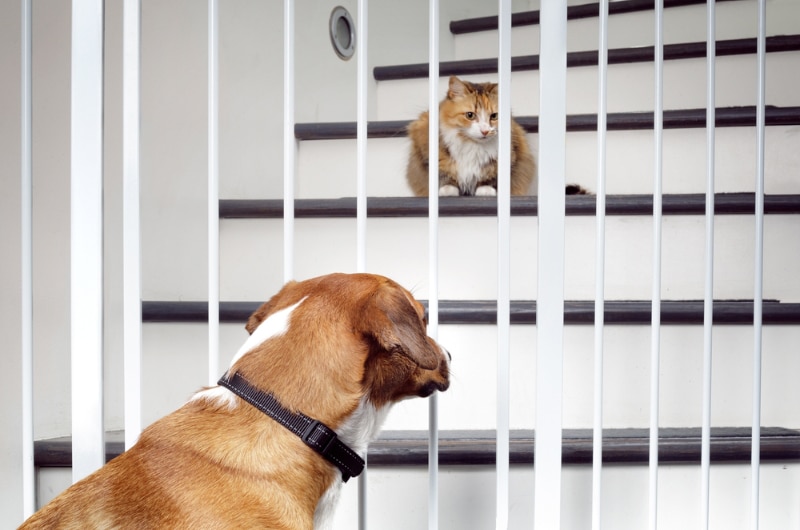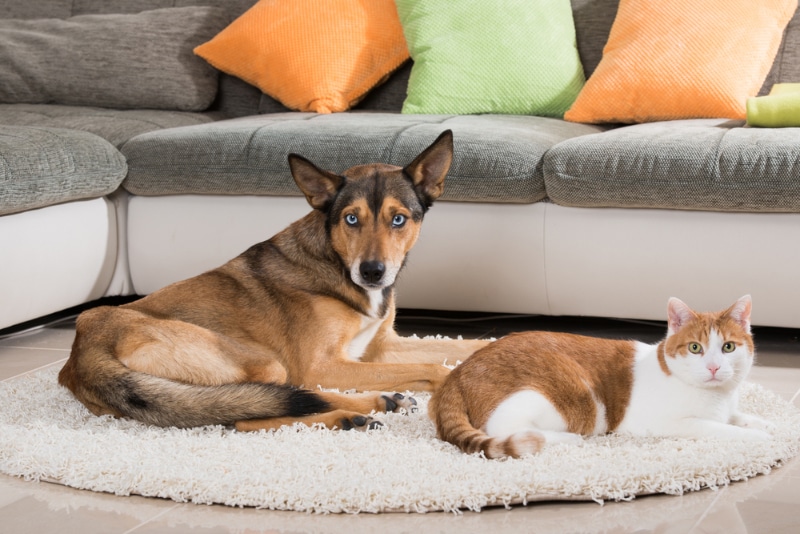Despite what is commonly believed by many, cats and dogs can live together. Sometimes, they can even become best buddies. However, this may take a lot of careful planning, patience, and supervision. You have to give each animal the space they need to make friends and the success of it will also greatly depend on the individual animal’s personality, early socialization, and previous experiences. Not all dogs will be able to live in a household with cats and this should be respected.
The key to making your cat and dog friends is going slowly. It’s vital that you follow each of these steps, not moving on to the next one until your pets are ready. It’s very important to always supervise your pets when they’re interacting together.

The 6 Tips to Make a Dog and Cat Friends at Home
1. Consider Your Pet’s Personalities
You should consider your pets’ personalities and histories when introducing them. If your dog has been around other cats since they were a puppy and they are calm and relaxed, introducing a new cat may not take several weeks. On the other hand, if your dog has a very high prey drive or always tries to chase a cat when they see one, introducing a cat to the home is a very touch-and-go process and not without risks. It may take your dog a month or more to tolerate the cat without chasing them, while some dogs will never be fine around cats and should live in a cat-free home.
Cats tend to be more fearful. Dogs tend to be more chase-oriented. Cats do not typically run after dogs. Therefore, most introduction instructions are based around the dog becoming desensitized and distracted. However, cats can absolutely become aggressive against dogs, especially smaller dogs or puppies, if they are adult or older cats. There are some very small dog breeds out there. In some cases, your puppy may be smaller than your cat!
If this describes your situation, you’ll probably need to flip the script. Focus on rewarding your cat when they are ignoring the puppy, and encourage the puppy to explore.
High-energy dogs may always be in the mood to chase. If your dog is ready to go and wants to chase the cats after several introductions, consider increasing how much exercise they get. The constant need to chase may be more closely related to a lack of exercise.
When getting one or the other pet, it’s best to aim for young animals, puppies, and kittens, as they are more impressionable at this age and easier to socialize with another species.

2. Set Up Your Home
The best way to encourage your pets to get along is to set up your home properly. Each pet should have their own safe haven that they can retreat to. Often, pets lash out when they feel cornered. However, they won’t feel cornered if they have somewhere to escape to. That’s why having separate spaces is important.
You don’t have to dedicate a whole room, though. Several high perches for your cat, where they can’t be disturbed by the dog and a crate or bed for your dog can be plenty for some animals. When possible, put these safe spaces out of the way of foot traffic and away from each other.
In the beginning, you do need to have separate rooms, if at all possible, though. A door between your cat and dog can prevent chasing and poor behaviors before they’re properly introduced. For some dogs, a baby gate will also work.
The goal of this first step is to decrease stress, making each pet a bit more comfortable overall.

3. Start Slow Introductions
Start introducing your cat and dog together slowly. Keep them physically separated, to begin with. Allow each one to get used to the presence of the other while a door or baby gate still safely separates them. You should allow each of them to sniff under the door or lay next to it. Your dog will probably be a bit obsessed with the cat for a day or two.
Right now, your only goal is to make the “newness” of each other dissipate. Once your dog is no longer sniffing continuously at the door and your cat is no longer avoiding it completely, you can consider moving on to the next step.
4. Supervised Meetings
Next, you’ll need an extra pair of hands. Each animal should have a “helper” to encourage proper behavior and remove the animal if necessary. Start with controlled, short meetings. You may let your dog peek at your cat through a slightly open door or put your dog on a leash while the cat comes out and explores. Reward each animal for not paying attention to the other pet and for exhibiting calm behavior. Your goal is to break any obsessive staring or your dog’s urge to chase and encourage each pet to ignore the other one.
We’ll get to “friends” later. Right now, we need to focus on “not enemies.” Another way you can do this is to place the dog in a crate and let the cat roam the room. Ensure the dog is not too excited and reward them with treats, while they’re calmly observing the cat.
While doing this process, respect each animal’s boundaries. You should never force contact. Don’t push your pets into the same room if one of them is fearful or uncertain. If the cat shows fear, they should be allowed to retreat into their safe space. In the meantime, you should focus on making your dog used to the cat, preferably ignoring them for the most part and just getting used to having them around.
Time is your best friend during this process. There is no need to rush it. One bad incident can make your cat fearful for weeks, so it is vital that everything is done as slowly as possible.

5. Use Positive Reinforcement
We touched on this a little bit, but it’s important enough to have its own section.
All introductions require time. However, you can somewhat reduce the amount of time required by using positive reinforcement. Reward any calm behavior with praise and treats. Encourage your dog to pay attention to you or a toy while the cat is exploring the area.
Reward the cat for exploring new areas and ignoring the dog. By rewarding the cat when the dog is in sight, you’re helping the cat associate your dog with good feelings beyond fear, and vice versa. With time, this process can help your cat be less fearful, which may encourage less chasing from your canine. Eventually, with your dog on a leash, allow the two animals to sniff each other, ideally one at a time. This means while distracting your canine with treats, let the cat sniff them, and while your cat is doing their own thing, allow the dog to come closer, while still being on a leash, allow the dog to gently sniff the cat while observing their body language. If they are anxious, scared, or excited, it’s best to skip the sniffing for now. The dog should be calm and relaxed.
Avoid punishing negative behaviors, as this only creates more fear. You should either be neutral or positive when interacting with your pets during the introduction process. Remove the pets from the meeting before things get out of hand. Always try to end on a good note, when possible, especially in the beginning.
6. Get Professional Help
Almost all dogs will try to chase cats, even well-socialized dogs. This behavior isn’t unusual and can be counteracted by following our steps above. However, aggression towards cats (or dogs, in some cases) isn’t normal.
If one of your pets is aggressive towards your other pet, it’s time to seek professional help. It’s also time to seek professional help if you’ve been consistent in your introductions but haven’t seen any progress in a month. After that many introductions, it’s clear that you need a different approach.
None of these necessarily mean that your cat and dog cannot live in the same household safely. However, you may need a different approach. A professional can help you ensure there isn’t an underlying reason for the aggression and help you come up with a training plan.
If you need to speak with a vet but can't get to one, head over to PangoVet. It's an online service where you can talk to a vet online and get the personalized advice you need for your pet — all at an affordable price!

Final Thoughts
Getting cats and dogs to live happily together can seem like a pipe dream. However, with the right procedure and plenty of patience, it is possible. Often, time can help you the most. Both of your pets should slowly become desensitized to each other as time goes on.
Remember to be patient when introducing your dog and cat. Consider both animals’ personalities, and try exercising your dog more if they seem particularly intent on chasing your cat.
While it isn’t usually necessary, you may need to consider getting professional help if your pets aren’t getting along after a month or more.
Featured Image Credit: Dora Zett, Shutterstock


















